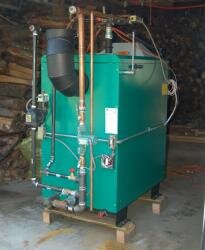Well after much thought I placed an order for an EKO 40 ! The parts should be arriving a couple of days and I have lots of work to do since I want to get it running ASAP so I can have heat without paying massive gas bills.
I am doing a "basic" system with DHW and an heat exchanger in the gas forced air furnace but no hot water storage (for now).
The EKO will be installed in a metal shed about 64' feet from the house and 115' from the furnace I am using Logstor insulated pipe outside and pex-al pipe inside that I also plan to insulate as the basement is not heated at this time.
I will be doing some of the work myself along with help from friends and family ... my pal next door will use his skid steer to move and position the boiler in the shed, a couple of nephews will build the shed and another will be doing the plumbing / furnace work.
I am doing the trenching this weekend!
Any suggestions on how to set things up and pitfalls to avoid would be welcome.
Thanks
I am doing a "basic" system with DHW and an heat exchanger in the gas forced air furnace but no hot water storage (for now).
The EKO will be installed in a metal shed about 64' feet from the house and 115' from the furnace I am using Logstor insulated pipe outside and pex-al pipe inside that I also plan to insulate as the basement is not heated at this time.
I will be doing some of the work myself along with help from friends and family ... my pal next door will use his skid steer to move and position the boiler in the shed, a couple of nephews will build the shed and another will be doing the plumbing / furnace work.
I am doing the trenching this weekend!
Any suggestions on how to set things up and pitfalls to avoid would be welcome.
Thanks


